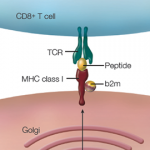Measuring & Communicating Risk
Based on the growing evidence, Dr. Sawalha and Dr. Casares-Marfil developed what’s known as a cumulative genetic risk score for Takayasu arteritis. “Basically the idea is that we now have a number of genetic susceptibility loci that we are confident about,” says Dr. Sawalha. “These are common genetic variants, so they are present in the general population. It’s just they happen to be enriched more in people who end up developing Takayasu.”
Considered one at a time, each genetic variant may not do much to increase an individual’s relative risk for developing the disease. But because everyone carries two copies of every SNP, the researchers can consider the additive effect of having none, one or two copies of every allele associated with a higher risk for Takayasu arteritis, multiplied by the estimated effect size of each of those alleles. Some alleles, like HLA-B*52 for example, have considerably larger effects than others. In sum, they can produce an estimate of someone’s cumulative genetic risk for Takayasu arteritis, similar to estimates produced for other diseases.
That risk score is unlikely to be useful diagnostically, Dr. Sawalha cautions, given that it’s based primarily on common genetic variants. It could, however, help explain differences or variability in disease prevalence among genetic ancestry groups. Using DNA samples donated by healthy individuals of African, East Asian, South Asian, European and mixed American genetic ancestry enrolled in the 1000 Genomes Project, the researchers found that the cumulative genetic risk partially explains the variability in disease prevalence seen across populations. The East Asian population, they found, had the highest cumulative risk score, while the mixed American population had the lowest score.
Given the caveats and unknowns, the researchers have developed a practical guide for communicating the genetic information to patients and their families. One of the most common questions asked by someone diagnosed with a rare disease is, “Are my children going to get it?” Dr. Sawalha says. To help put someone’s susceptibility in perspective, the two biggest considerations are the disease’s rarity and the relative risk for people who have disease-associated alleles that their healthy counterparts lack. In this case, he says, because Takayasu arteritis is quite rare, a two- or fourfold increase in relative risk would still yield a low overall risk.
To improve how the disease is treated, far more research into the underlying mechanisms of Takayasu arteritis will be necessary. For rheumatologists, Dr. Sawalha says, one big take-home lesson is the necessity of working together across institutions to conduct such research, including sharing data, providing samples and recruiting patients. “For rare diseases like Takayasu, it’s important that the community gets together to collaborate,” he says. “We cannot do any of this work without extensive international collaboration.”

